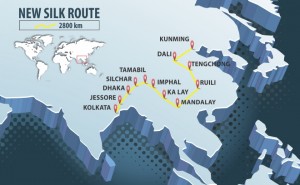Published in The Daily Star on Thursday, 6 March 2014.
Route of hope beckons
Bangladesh expects business boom as 4 countries to build transnational highway
Rejaul Karim Byron and Md Fazlur Rahman
Bangladesh, India, China and Myanmar are likely to sign an agreement to build a transnational highway that will eventually turn Bangladesh into a hub of connectivity between South and Southeast Asia.
The framework agreement may be inked in December in New Delhi at the third intergovernmental meeting on the proposed Bangladesh, China, India, Myanmar Economic Corridor (BCIM-EC), according to foreign ministry officials.
The deal is aimed at boosting trade and investments and tapping regional economic potentials. It will help Bangladesh get optimum return from its proposed deep-sea port that could be used by all four countries, they said.
“The foreign ministry, the Centre for Policy Dialogue and Bangladesh Institute of International and Strategic Studies are jointly conducting a study to identify possible areas of cooperation under the corridor,” said former director general of the foreign ministry Sheikh Mohammad Belal, who was involved in the BCIM-EC initiative.
Talking to The Daily Star, Prime Minister’s Adviser on Foreign Affairs Gowher Rizvi said, “Bangladesh wants to be the hub for connectivity between South and Southeast Asia, and the corridor fits exactly into that.”
“Bangladesh also stands to gain because it will allow the country to expand economic ties with India, China and Myanmar.”
The adviser, however, said it would require big investments to establish the corridor. Construction of roads might be “technically feasible”, but it will take time to get funding.
Besides, coordination among the four governments could be time-consuming, he said.
“But in the meantime, we can develop, along the planned corridor, pockets of economic activity and industrial park so that while the corridor comes into being, we shall have a very flourishing economy.”
POSSIBILITIES
The K2K (Kunming-Ruili-Bhamo-Lashio-Mandalay-Tamu-Imphal-Sylhet-Dhaka-Kolkata) route, which is 2,800 km long and part of the historic Silk Route, offers the best condition to be used as the corridor, according to a concept paper on the BCIM-EC.
The paper was presented at an inter-ministerial meeting in Dhaka on February 6.
With roads, railways, airlines, water routes, telecommunication networks and energy pipelines, the corridor will connect Southwestern China, Eastern and North-Eastern India, Myanmar and Bangladesh to form a thriving economic belt.
The paper outlines the growing competition between China and India on political and economic fronts and the Myanmar refugee issue as areas of concern at country level.
Inadequate market access, non-tariff barriers, insufficient physical connectivity and lack of favourable banking and financial mechanisms might pose challenges at sector level, it says.
Besides, intra-BCIM trade has remained fairly low though it increased — mainly driven by China and India — from $6 billion in 2001 to $90 billion in 2011. And the contribution of Bangladesh and Myanmar is meagre.
The trade potential of the corridor stands at $132 billion, according to a study by Research and Information System for Developing Countries in India.
According to Bangladesh foreign ministry’s concept paper, the country can benefit immensely from regional cooperation on energy, as it can purchase unused power from Sikkim in India that plans to exploit its hydrocarbon resources.
Bangladesh can also increase trade with Myanmar, as the two countries share a border of 160 miles. It can also gain similar benefits from China and India.
Allowing China to link up with the planned deep-sea port in Sonadia would be a lucrative offer for the economic giant, as Yunnan province is nearer to Chittagong than it is to Shanghai or Beijing, said the paper.
The BCIM-EC initiative began mainly as a private sector effort in 1999 with the launching of a joint forum of Bangladesh’s CPD, China’s Yunnan Academy of Social Sciences, India’s Centre for Policy Research and Myanmar’s border trade ministry.
It got a boost last year when China and India showed interest in utilising the BCIM framework for enhancing connectivity in the region. Bangladesh and Myanmar also responded positively.
The first inter-governmental meeting on the BCIM-EC took place in Kunming of China in December last year.
It decided that the four countries would separately prepare 11 study reports on issues such as scope and elements of the corridor, framework of cooperation, connectivity, energy, investment and financing, trade in goods and services, trade facilitation and people-to-people contact.
A combined report based on sector-wise studies by the four countries is likely to be produced at the second inter-governmental meeting on the BCIM-EC in Chittagong in June.
The report will contain details of the projects and financing required for establishing connectivity under the corridor that will cover 1.65 million square kilometres and touch the lives of 44 crore people, said officials.
Prof Mustafizur Rahman, executive director of the CPD, said trade and investment would go up if transport connectivity is established between the four countries.




